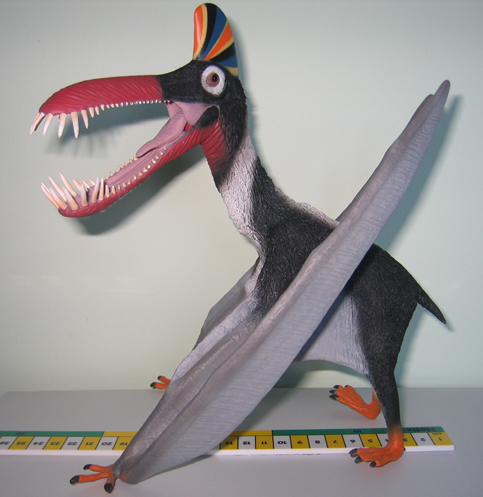More Evidence to support a Quadrupedal stance in Pterosaurs
A new, scientific study has been published that examines pterosaur locomotion.
The pterosaurs are an extinct group of flying reptiles. Known from the fossil bearing strata dating from the Triassic to the end of the Cretaceous, these bizarre creatures were the first truly diverse and successful flying vertebrates (not withstanding one or two genera of Permian gliders). The wings of these strange reptiles were formed out of skin that stretched from the body over the forelimbs and were supported by an elongated fourth digit.
Pterosaur Locomotion
For many years scientists have debated the aerial capabilities of these flying reptiles. Studies of endocasts of braincases and papers written on these animal’s ability to balance have been published and many researchers now believe that these animals were very capable fliers. However, whilst graceful and fully at home whilst airborne, how these animals moved around on the ground has long been debated. It has been argued, almost since the first pterosaur fossils were studied in the 18th Century, that these animals were clumsy on land.
Some scientists have proposed that these animals had a bipedal stance (especially the larger pterosaurs such as the Late Cretaceous azhdarchids), whilst others have proposed a quadrupedal stance.
Studying Footprints and Tracks
Ichnologists (scientists who specialise in the study of footprints and tracks), have found a number of pterosaur trackways. A paper was published recently on a set of tracks made by a large pterosaur and preserved in Upper Cretaceous strata in Mexico. These indicate a quadruped gait and stance. This evidence is supported by trace fossils from perhaps the best preserved pterosaur trackway site in the world, that found in the Upper Jurassic limestone deposits of Crayssac in south-western France.
A number of pterosaur tracks have been identified in the Crayssac site. Some scientists have argued that previously described pterosaur trackways may actually be crocodilian but the absence of a tail drag and five digit impressions at the French location suggest that the majority of the trackways ascribed to various types of pterosaur have been accurately described.
Different Trackways
A number of different sized and different length trackways are known from this region. They indicate the presence of a number of different types of pterosaur in the environment at the time. The trackways were made in shallow, inter-tidal water and some of the tracks are several metres in length. Crucially, the tracks indicate a quadrupedal gait, and, surprisingly measurements taken by French scientists indicate that some of these pterosaurs were capable of moving quite quickly when on the ground. How these animals took off, or landed has yet to be determined, but it is suggested that these graceful reptiles were capable of touching down or taking off in a similar fashion to modern birds.
Some of the footprints indicate that certain species had webbed feet, an adaptation to their marine environment. Perhaps these animals filled an ecological niche similar to extant pelicans of today.
A Pterosaur Model – CollectA Deluxe/Supreme Guidraco Figure

The colourful CollectA Deluxe/Supreme Guidraco pterosaur model showing the quadrupedal stance. Model has an articulated jaw. Picture credit: Everything Dinosaur.
Picture credit: Everything Dinosaur
Everything Dinosaur stocks a wide range of pterosaur figures including the: CollectA Deluxe/Supreme model range.






Leave A Comment